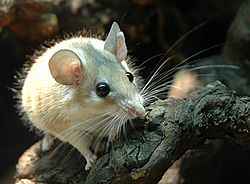Myomorpha facts for kids
Myomorpha is a big group of small, mouse-like animals. It includes many familiar creatures like mice, rats, hamsters, and gerbils. These animals are a type of rodent. There are over 1,100 different kinds of Myomorpha species. This means almost a quarter of all mammals on Earth belong to this group!
Quick facts for kids MyomorphaTemporal range: Early Eocene - Recent
|
|
|---|---|
 |
|
| Acomys cahirinus | |
| Scientific classification | |
| Kingdom: | |
| Phylum: | |
| Class: | |
| Subclass: | |
| Order: | |
| Suborder: |
Myomorpha
Brandt, 1855
|
| Superfamilies | |
Contents
What are Myomorphs?
Myomorphs are a special group of rodents. Scientists group them together based on how their jaws and molar teeth look. These animals are very good at biting and chewing their food. This helps them eat many different things.
Where do Myomorphs Live?
You can find Myomorphs almost everywhere on Earth. They live on every continent except Antarctica. They are found in nearly all kinds of land habitats. This includes forests, deserts, grasslands, and even cities.
What do Myomorphs do?
Most Myomorphs are more active at night. This means they are nocturnal. They often search for food when it is dark. Many of them are seed-eaters, which means seeds are a big part of their diet. They also eat other plant parts and sometimes insects.
Myomorpha Families
The Myomorpha group is divided into two main superfamilies. These are like big families of animals. Each superfamily then has smaller families inside it.
Muroidea Superfamily
The Muroidea superfamily is the largest group of Myomorphs. It includes many animals you might know.
- Platacanthomyidae: These are spiny dormice.
- Spalacidae: This family includes mole-rats and zokors.
- Calomyscidae: These are called mouse-like hamsters.
- Nesomyidae: This group has African and Malagasy rodents.
- Cricetidae: This family includes hamsters, voles, and lemmings.
- Muridae: This is the biggest family. It includes common mice and rats.
Dipodoidea Superfamily
The Dipodoidea superfamily has fewer families.
- Dipodidae: This family includes jerboas and jumping mice. Jerboas are known for their very long hind legs. They use these legs to hop around.
See also
 In Spanish: Myomorpha para niños
In Spanish: Myomorpha para niños

